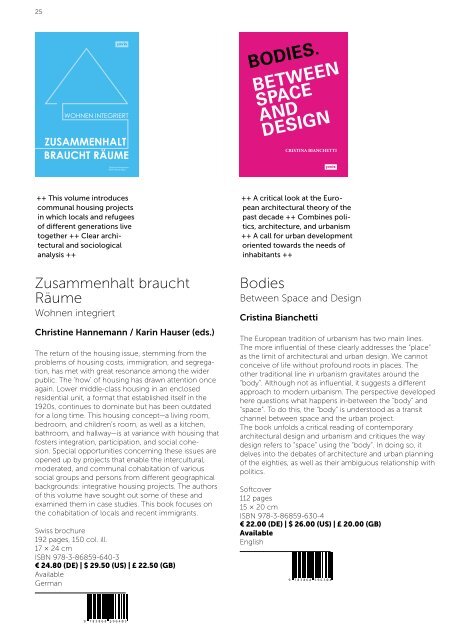JOVIS Catalog Spring 2021
Create successful ePaper yourself
Turn your PDF publications into a flip-book with our unique Google optimized e-Paper software.
25<br />
WOHNEN INTEGRIERT<br />
ZUSAMMENHALT<br />
BRAUCHT RÄUME<br />
BODIES. BETWEEN SPACE AND DESIGN<br />
BODIES.<br />
BETWEEN<br />
SPACE<br />
AND<br />
DESIGN<br />
CRISTINA BIANCHETTI<br />
Christine Hannemann<br />
Karin Hauser (Hg.)<br />
++ This volume introduces<br />
communal housing projects<br />
in which locals and refugees<br />
of different generations live<br />
together ++ Clear architectural<br />
and sociological<br />
analysis ++<br />
Zusammenhalt braucht<br />
Räume<br />
Wohnen integriert<br />
Christine Hannemann / Karin Hauser (eds.)<br />
The return of the housing issue, stemming from the<br />
problems of housing costs, immigration, and segregation,<br />
has met with great resonance among the wider<br />
public. The ‘how’ of housing has drawn attention once<br />
again. Lower middle-class housing in an enclosed<br />
residential unit, a format that established itself in the<br />
1920s, continues to dominate but has been outdated<br />
for a long time. This housing concept—a living room,<br />
bedroom, and children’s room, as well as a kitchen,<br />
bathroom, and hallway—is at variance with housing that<br />
fosters integration, participation, and social cohesion.<br />
Special opportunities concerning these issues are<br />
opened up by projects that enable the intercultural,<br />
moderated, and communal cohabitation of various<br />
social groups and persons from different geographical<br />
backgrounds: integrative housing projects. The authors<br />
of this volume have sought out some of these and<br />
examined them in case studies. This book focuses on<br />
the cohabitation of locals and recent immigrants.<br />
Swiss brochure<br />
192 pages, 150 col. ill.<br />
17 × 24 cm<br />
ISBN 978-3-86859-640-3<br />
€ 24.80 (DE) | $ 29.50 (US) | £ 22.50 (GB)<br />
Available<br />
German<br />
++ A critical look at the European<br />
architectural theory of the<br />
past decade ++ Combines politics,<br />
architecture, and urbanism<br />
++ A call for urban development<br />
oriented towards the needs of<br />
inhabitants ++<br />
Bodies<br />
Between Space and Design<br />
Cristina Bianchetti<br />
The European tradition of urbanism has two main lines.<br />
The more influential of these clearly addresses the “place”<br />
as the limit of architectural and urban design. We cannot<br />
conceive of life without profound roots in places. The<br />
other traditional line in urbanism gravitates around the<br />
“body”. Although not as influential, it suggests a different<br />
approach to modern urbanism. The perspective developed<br />
here questions what happens in-between the “body” and<br />
“space”. To do this, the “body” is understood as a transit<br />
channel between space and the urban project.<br />
The book unfolds a critical reading of contemporary<br />
architectural design and urbanism and critiques the way<br />
design refers to “space” using the “body”. In doing so, it<br />
delves into the debates of architecture and urban planning<br />
of the eighties, as well as their ambiguous relationship with<br />
politics.<br />
Softcover<br />
112 pages<br />
15 × 20 cm<br />
ISBN 978-3-86859-630-4<br />
€ 22.00 (DE) | $ 26.00 (US) | £ 20.00 (GB)<br />
Available<br />
English


















